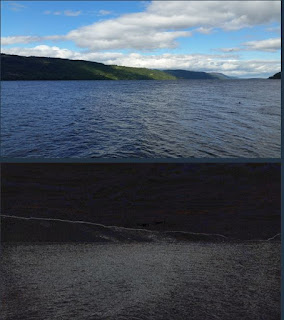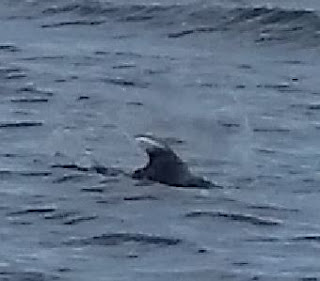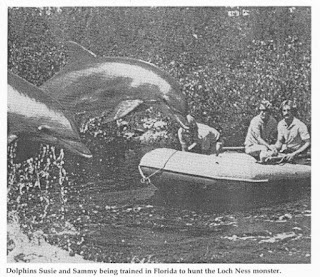I will be driving off to Loch Ness soon as I take a few days break. With the recent photographs of dorsal fins and strange looking water disturbances, I feel a bit more stoked than usual as I think through the activities that will be done. That is also set against messages I am getting that some new and potentially better photographs will soon be published. I haven't seen them, so it's really a matter of wait and see.
In fact, another photograph hit the news as I was typing this article and it produced a very weird looking "animal". It was taken halfway between Dores and Inverfarigaig last Saturday afternoon by an Ian Bremner who claimed he did not notice it until he reviewed his images later. The original story can be found here.
In fact, another photograph hit the news as I was typing this article and it produced a very weird looking "animal". It was taken halfway between Dores and Inverfarigaig last Saturday afternoon by an Ian Bremner who claimed he did not notice it until he reviewed his images later. The original story can be found here.
Now when I zoomed in on the head, my first thought was "seal". But, of course, the rest of a seal does not normally look like what followed. A classic head and two humps or three seals swimming in a line? The mind began to boggle ... first the dorsal fin of a dolphin and now three seals chasing each other. Loch Ness is getting crazy these days.
But I recalled what fellow monster hunter, Gordon Holmes, said to me only five days ago from his base at Loch Ness:
I went down to the shore next to the new floating jetty at 8.43pm. Then immediately saw the outline of a small, say 17 inch wide domed dark head which seemed to be aware of my presence and just sank within less than one second. This was at the very extreme dregs of daylight. Too dark to confirm additional sightings ... 65% percent certain, it was a seal.
Looks like your powers of observation could be correct, Gordon. But three seals? Not likely, but possible. In fact, when I saw the picture, it reminded me of this photo I clipped a while back from Whipsnade Zoo in 1955.
And how could we forget that amusing manatee cartoon!
But, if these are three seals, it is still a remarkable picture. However, like the dorsal fin, I would expect some confirmatory pictures. After all, three seals in Loch Ness, should not be so easily hidden. Perhaps I will spot them myself as I head up to the loch this weekend.
Meanwhile, the weather forecast for Loch Ness doesn't look too bad and so I hope to do my usual routines plus some new stuff. I also intend to be at the "Monster Masterclass" run by Jacobite Cruises on the 18th September which will include Nessie stalwarts Steve Feltham, Gary Campbell and Willie Cameron. You can find out more details at this link.
But I recalled what fellow monster hunter, Gordon Holmes, said to me only five days ago from his base at Loch Ness:
I went down to the shore next to the new floating jetty at 8.43pm. Then immediately saw the outline of a small, say 17 inch wide domed dark head which seemed to be aware of my presence and just sank within less than one second. This was at the very extreme dregs of daylight. Too dark to confirm additional sightings ... 65% percent certain, it was a seal.
Looks like your powers of observation could be correct, Gordon. But three seals? Not likely, but possible. In fact, when I saw the picture, it reminded me of this photo I clipped a while back from Whipsnade Zoo in 1955.
And how could we forget that amusing manatee cartoon!
But, if these are three seals, it is still a remarkable picture. However, like the dorsal fin, I would expect some confirmatory pictures. After all, three seals in Loch Ness, should not be so easily hidden. Perhaps I will spot them myself as I head up to the loch this weekend.
Meanwhile, the weather forecast for Loch Ness doesn't look too bad and so I hope to do my usual routines plus some new stuff. I also intend to be at the "Monster Masterclass" run by Jacobite Cruises on the 18th September which will include Nessie stalwarts Steve Feltham, Gary Campbell and Willie Cameron. You can find out more details at this link.
Meantime, I leave you with this video I put together recently. It is one of my dawn runs by car up "Monster Alley". This is the stretch of road between Inverfarigaig and Dores where the monster has been most reported coming onto land. What better way to relax than drive up this road as darkness is beginning to recede with the possibility of running into a nocturnal Nessie fleeing from the light like some aquatic vampire?!
Okay, that's a bit tongue in cheek as land reports of the monster are even rarer than water sightings and the odds of one being near the creature in such a scenario is very small. But still, I do this run every trip with my dashcam camera attach to the car window ... just in case.
The stillness of the night and the complete absence of anyone else does focus the mind a bit more. I am also not quite certain what my strategy should be if a 30 foot long creature does emerge from the forest to the loch? Run it down and solve the mystery forever or get as much recorded data as possible and let it go? I think the answer is obvious. But who knows? Perhaps I will film a "huddle" of three seals crossing the road!
You can play the 25 minute video at this link.
The author can be contacted at lochnesskelpie@gmail.com
































